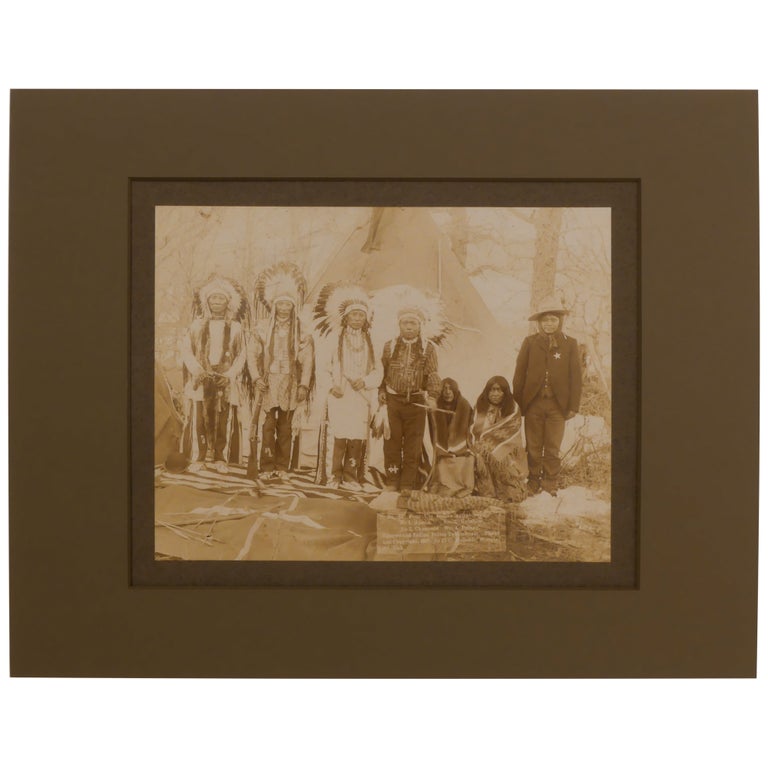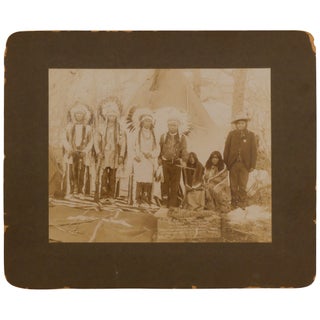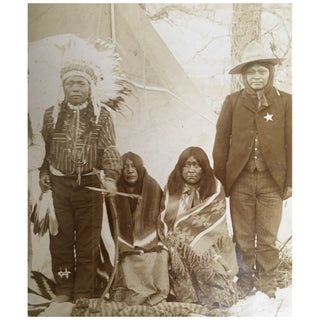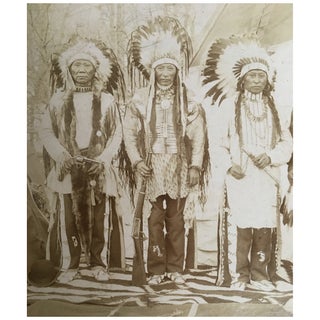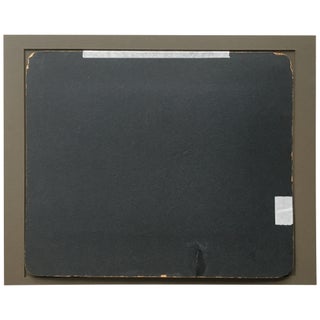Image from the Last Ute Uprising
Four Ute Agitators. No. 1, Apona. No. 2, Chuponis. No. 3, Rainbow. No. 4, Pompy. Squaws and Indian Police Tabbichoats
Notes: An image from the Ute Uprising of 1907, the last confrontation between Plains Indians and the US Army. This albumen silver print shows four White River Ute leaders in feathered headdresses and a combination of Western and native clothing, with two women wrapped in blankets and a tribal police officer wearing Western clothing and a five-pointed star badge. The figures stand on very large blankets with a teepee in the background. There is snow on the ground, suggesting the image was taken during the winter.
One of the Ute men holds a pistol, another a rifle, another a bow and two arrows, and the fourth what appears to be a flageolet, or wood flute. The tableau seems to convey a willingness to fight with modern weapons and an allegiance to tradition.
The photograph was likely taken near Fort Meade after a group of Utes, who had been relocated to a reservation in Utah from their ancestral lands in Colorado, journeyed to South Dakota to join the Sioux, creating a problem for the US government over where they would live and how they would be supported. The Utes had met with Theodore Roosevelt in 1905 to express their opposition to the reservation being created in Utah and the White River Band walked out of the talks when it became apparent that the US government had decided that they should be placed on a Utah reservation, regardless of their wishes. This band made the trek to South Dakota in 1906.
The White River Band again met with Roosevelt in 1907. The president agreed that they could stay in South Dakota but they would have to find work and send their children to school. The Utes refused. Tensions rose and a confrontation with the Army was narrowly averted. In 1908, the White River Band agreed to return to Utah, escorted by the army. Several dozen members of the band died in South Dakota, from the cold and disease. "Their departure from Fort Meade in late June 1908 brought an end to the so-called Ute uprising. The Utes/ confrontation with the army was the last of its kind for the Plains Indians" (quoted from David D. Laudenschlager, "The Utes in South Dakota, 1906–1908", South Dakota History, 1979.
There is another, more common version of this image, in which Tabbichoats is holding the reins of a horse.
8-7/16 by 6-5/8 inches on a larger dark gray card mount.
Edition + Condition: The photograph is a low-to-medium contrast print, somewhat overexposed, perhaps in the negative. The print is clean and clear, however. The mount has a one-inch crack at the bottom (not affecting the image) and chipped, rounded corners. It is affixed to a modern mat with framer's tape on the verso.
Publication: Sturgis, So. Dak. C. C. McBride, 1907.
Item No: #307607
Sold

